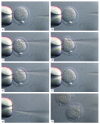Generating CRISPR/Cas9-Derived Mutant Mice by Zygote Cytoplasmic Injection Using an Automatic Microinjector
- PMID: 31164552
- PMCID: PMC6526459
- DOI: 10.3390/mps1010005
Generating CRISPR/Cas9-Derived Mutant Mice by Zygote Cytoplasmic Injection Using an Automatic Microinjector
Abstract
Clustered regularly interspaced short palindromic repeats (CRISPR)/CRISPR-associated (Cas) assisted generation of mutant animals has become the method of choice for the elucidation of gene function in development and disease due to the shortened timelines for generation of a desired mutant, the ease of producing materials in comparison to other methodologies (such as embryonic stem cells, ESCs) and the ability to simultaneously target multiple genes in one injection session. Here we describe a step by step protocol, from preparation of materials through to injection and validation of a cytoplasmic injection, which can be used to generate CRISPR mutants. This can be accomplished from start of injection to completion within 2-4 h with high survival and developmental rates of injected zygotes and offers significant advantages over pronuclear and other previously described methodologies for microinjection.
Keywords: CRISPR/Cas9; cytoplasmic injection; microinjection; zygotes.
Conflict of interest statement
The authors declare no conflict of interest.
Figures




References
Grants and funding
LinkOut - more resources
Full Text Sources
Other Literature Sources

